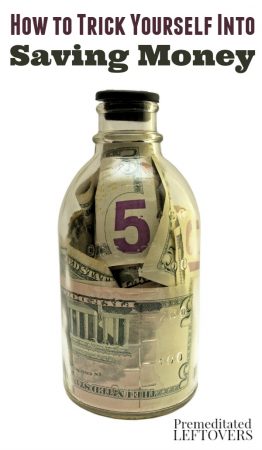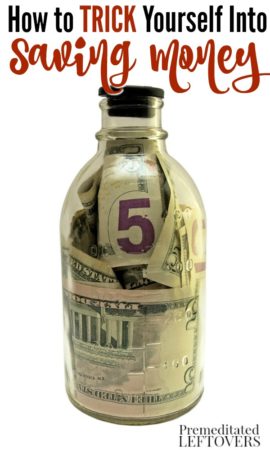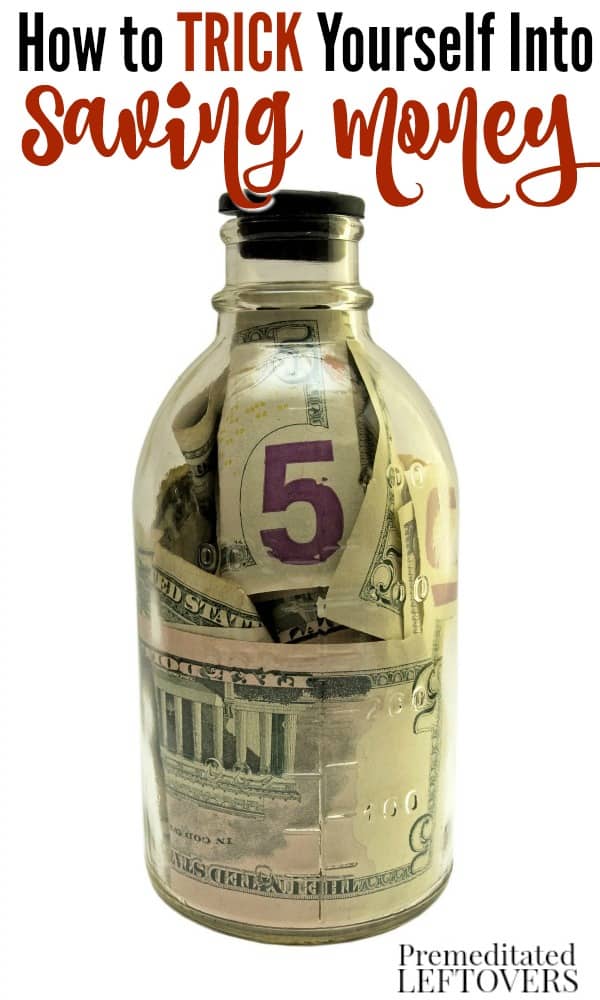Use these tips for how to trick yourself into saving money to build your savings account.

Saving money is very hard to do when you either have a spending habit or a very small budget to work with, or a combination of the two. It doesn’t have to feel painful to put money away. You can save money in ways that trick yourself into thinking you aren’t putting that much money away. Here are some ways to do just that.
How to Trick Yourself into Saving Money
Save all your change and only use paper money to pay for things. Saving change is an amazing way to save money that will not even be noticeable to your day to day spending. It can really add up quickly, too! My family has a family piggy bank jar that we all toss money into. Every few months, we count it out and take it to the bank. We have had over $100 in there before and didn’t even know it.
Do the 52 Week Money Challenge. While this is ideal to start at the beginning of the year, you can join in at any time and it still matters. Just save the number of dollars that is the same week of the year. For instance, the first week of the year, you would only save $1. The second week, $2. By the end of January, you will have over $10 in your savings. If you join in April, you will be at week 12, so you put $12 in your savings. Just keep doing this and at the end of the year, you will have over $1,000 in your savings! You can find a printable to keep track of your 52 Week Savings Challenge here.
Penny Challenge – If a dollar a week is too much to contemplate, try the penny challenge instead. On the first day of the year you put a penny in a container, on the second day you put 2 pennies in…on the one-hundredth day you put in 100 pennies or $1.00…on the last day you put 365 pennies or $3.65. It adds up to over $600.00. Keep track with this printable tracking form for the Penny Challenge.
Use placing a small amount in savings as just another bill you pay. It’s called “Paying yourself first”. Just add $10 or $20 or whatever amount to your savings as you are paying bills. Consider paying yourself as another expense, not an after-thought.
Save all $1 or $5 bills. Any time you get $1 or $5 bills, save them. You won’t notice much if it is just these small amounts at a time and they will add up very quickly. This is especially an easy way to save if you work a job that you get tips at.
Continue to make payments on loans after they are paid off. I don’t mean to the lender, but to your savings account. Set aside a period of time, say 6 months to a year, where you will make payments on time to your bank account for the same amount you were paying. At the end of the period, use it as a down payment on something else or spend it on another need or want.
If you shop at a grocery store that tells you how much you saved on the trip with either sales or coupons, set aside that amount when you go. After all, it was money you would have spent had it not been for coupons, so it should go into savings for something else.
Decide on a number. At the end of the week or day, look at your bills left in your wallet. If they are small ones, look and see if the number you chose is one of the bill’s serial ending number. If it is, into the savings it goes.
If you aren’t sure that you can commit to saving all of your $5 dollar bills or set aside a certain amount for savings each week, you might want to use a Budget Planner to track your spending. It will help you identify wasteful spending, where you can make realistic cuts, and find money to direct to savings.





Diamond Creations says
Wow! I think that I can use several of these! Thank you! I like the 52 week flip idea someone suggested. It’s true for me too that I seem to be lighter on the savings at the end of the year. I would like to add that one way that I started to “pay myself” was to have 10% of my paycheck directly put into my savings on payday. My employer offers the option to split where your pay check is deposited to.
Kerie says
I set up $50 automatic transfers to an online account not connected to our regular checking and savings accounts. Every time my husband and I get paid (4x per month) $50 is automatically deposited into that account. It takes a little longer to transfer it if we needed it, but it has an ATM card, so we could get cash same day in a true emergency. The card stays in the safe. We quickly built up a small emergency fund, which we hope to grow into a one-month then three-month cushion.
Alea Milham says
Brilliant idea!
Debrashoppeno5 says
These are wonderful tips. I need to get back to doing this.
Emily says
These are great suggestions, especially to continue paying a loan amount into savings even after the actual loan has been paid off. Thanks for linking up with Merry Monday this week!
Leslie says
I feel like our family should start the “paying yourself’ method right away. Why is it so hard to avoid thinking of your savings as an afterthought? That said, I really love the idea of just pretending to extend the length of a load and pay yourself instead. If you’re already used to having that money taken out of your income, then stay used to it and save up instead!
STEVE says
Heres a little trick i use every week and its amazing.
Say for instance my pay check is 652.43. I take the 52.43 and put that into savings. Then i have just 600 to spend for the week. Not to mention my checking account is connected to my savings. When i spend like a dollar and a penny on something, my bank automaticly rounds up to the next dollar and puts .99 into my savings. I dont even know its happening but every so often I check my savings ballance and WOW! Now i just act like i dont even have that money.
Ishekia says
I love this idea. Think I’m gonna try it. Thanks for posting.
Monica Roumillat Nailling says
I transfer any leftover money I have at the end of the week on payday into savings. Just stated it two weeks ago. The first week I transfered 26.48 and this past week I trasfered 18.40. This is rewarding because it causes you to give a second thought to spending your money on wasteful items. The higher percentage of your paycheck you transfer over on your payday the better it makes you feel.
Lisa says
Hi Christine,
your tips for saving money are great, I couldn’t think of the “number thing” about bills myself 🙂
Yet, I have a tip about the 52 week challenge. I would turn it the other way round and save 52 bucks in the first week, 51 in the second and so on because for many of us, the last weeks of the year are quiite expensive and on the other side, in the beginning of the year saving the bigger amounts would be easier since people received “christmas money” ( translated word by word from german, I don’t know if it’s a common thing in the US (?) but here, often people receive a 13. salary in the end of the year). And if not, students like me received some money as christmas present which would make it easier as well 🙂
So, anyway, that was my contribution 🙂
Have a nice day!
Jen says
I love the “Continue to pay loans” trick. After I paid off my car, I was used to spending $350/month. I diverted it to savings. My personal loan was another $150, and that went to savings as well. The one credit card I paid off was $100/month. Adding those to my base amount of savings means I drop $800/month into savings! 😀 I’m saving for a down payment on a house.
Alea Milham says
That’s awesome! $800 a month will add up fast!
Julia @ Real Mommy says
Great tips!
I actually love the “choose a number” idea, would be a great one to play with the kids, and also a great habit to pass onto them!
Thanks:)
Lisa @ The Wellness Wife says
Great tips! We paid off our home equity loan and are now putting that money towards my stepdaughter’s college fund. It was money we weren’t used to having anyway, so it has been a great way to build up the savings!
Penny says
These are great suggestions. I always seem to forget to pay myself first. I think we will start the 52 week challenge. Thanks for the reminder!
Millie Sargent says
I have been doing the 52 week challenge for about 3 years, it is fun and at the end of the challenge you have $1378.00. There is a chart you can print off if you google 52 week money challenge.